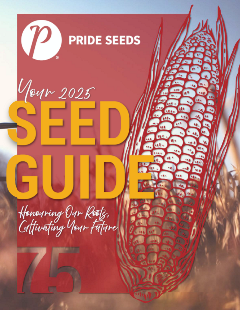WELCOME JEREMY O'SHEA TO PRIDE SEEDS

Enhance your knowledge and stay ahead with PRIDE SEEDS Corn and Soybean School videos.
Browse our selection of products below
___________________________________________________________________________________________________________________________________________

2024-2025 PRIDE Seeds Product GuideYou can find all of our products on the website, including supporting performance data and create your own personalized guide called My Guide. You can also download the digital version of our printed product guide which includes product comparison charts. |
SHOP THE PRIDE SEEDS E-STORE
-7.png?sfvrsn=87920db3_3)
STAY UP-TO-DATE WITH PRIDE SEEDS LATEST BLOGS, NEWS AND ARTICLES
Corn Planting Checklist - Part 2
There are many unique factors to consider when planting corn. This can be overwhelming for some, especially during the busy and stressful spring months. To set your corn crop up for success, we will focus on five corn planting checklist items to keep in mind this spring.
Planting Population
Targeted planting population for corn can range from 28,000 - 34,000 seeds/ac in most regions of Western Canada. Planting population is influenced by numerous factors such as: climate, end use, soil type and productivity, resources available, planting date, hybrid characteristics, CHU region and economics. On farm trials can be a great way to determine the perfect planting population for your operation.
Use a Planter
Planters use singulated meters, resulting in seed being placed accurately and consistently in the seedbed allowing for even spacing within the row and consistent seed depth. The planter’s metering capabilities dictate the planter speed. Generally, planters run at 4-4.5 mph (5 mph at the fastest). As planting speed increases, spacing within the row and depth uniformity decreases. Using a planter at the proper operating speed can help ensure that your corn seed is spaced properly, at the proper depth and has good seed-to-soil contact for germination to begin.
Depth
The target planting depth for corn is 1.5– 2.5”. We target this depth to achieve good seed-to-soil contact and good development of the nodal root system. This nodal root system is critical for structural support, as well as nutrient and water uptake. Planting at an even depth will help ensure even plant emergence, but we also need to consider how much moisture is in the soil at this planting depth. It is important to aim for planting into 0.5” of moisture to allow the corn seed to start imbibing water which will start the germination process. Consequences of planting too shallow or too deep:
| Too Shallow: < 1.5" | Too Deep: > 2.5" |
| Poor development of nodal root system | Delayed / no emergence |
| Early season lodging | Leafing out underground |
| Poor plant health mid-late season |
Soil Temperature
The soil temperature when planting corn should be 10˚C at planting depth with a 48-hour warming trend in the forecast. This is crucial because corn does not germinate below 10˚C; it is very temperature sensitive. We must wait for warm soils to avoid imbibitional chilling & cold injury.
- i. Imbibitional chilling occurs when there is a drastic change in the water temperature during imbibition (when the seed is taking in water). The critical time for this to occur is within 24 hours of planting.
- ii. Cold Injury is when there is a change in the soil temperature after the seed has imbibed water. Cold injury is typically less severe than imbibitional chilling. When we have cool spring soil temperatures and cool weather in the forecast it is better to leave the seed in the bag.
Seed Bed Preparation
Corn needs to be planted into a field with a firm seed bed and residue that has been well managed. In fields with a lot of residue or in no-till till operations, the planter can have difficulty reaching and maintaining the target planting depth and hair-pinning can occur. Hair pinning occurs when residue gets pushed up into the seed slot and as a result, seed to soil contact is reduced. Row cleaners can be added to the planter unit to move debris out of the row in fields with a lot of residue. On the other hand, excessive tillage can also cause issues when planting because of crusting and compaction of the soil. The goal is to have a firm seedbed that crumbles when squeezed, this will help with seed-to-soil contact and good nodal root development.
Proper planting is critical to maximizing yield. You only get one opportunity to plant your corn crop for the year, so taking a little extra time to make sure it’s done right can have a significant payoff.
TAKE PRIDE IN YOUR INBOX
Expert advice, news and information
THE PRIDE SEEDS ADVANTAGE
Farming is one of the most demanding industries in the world, subject to a variety of factors such as time, weather, and global pressures. You know this every time you look out the window and think about the field in front of you. Growers and dealers deserve an advantage: The PRIDE Seed Advantage.
LEARN MORETHE PRIDE SEEDS ADVANTAGE
Every year PRIDE Seeds works hard to produce leading-edge products that enable success where it matters most, on your farm. Our dedicated team strives to provide sales expertise, agronomy support, quality production, and service tailored to meet your needs.
LEARN MORE

Leave a commentOrder by
Newest on top Oldest on top